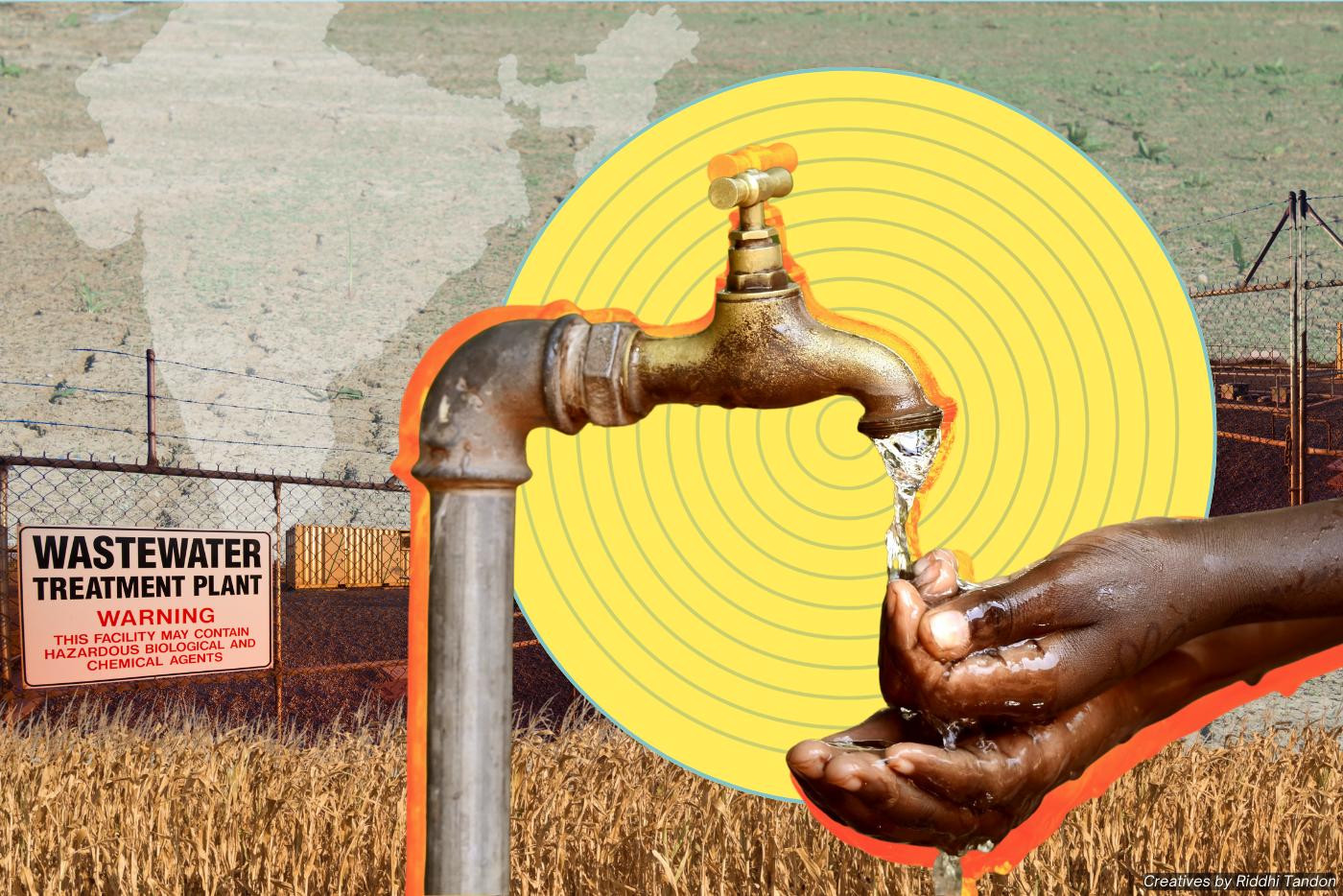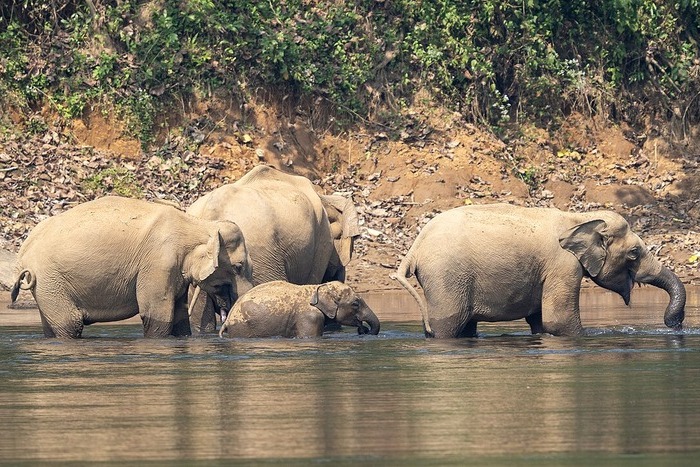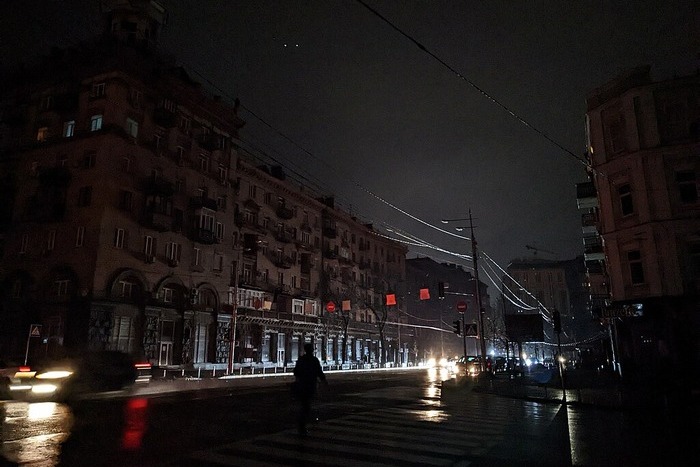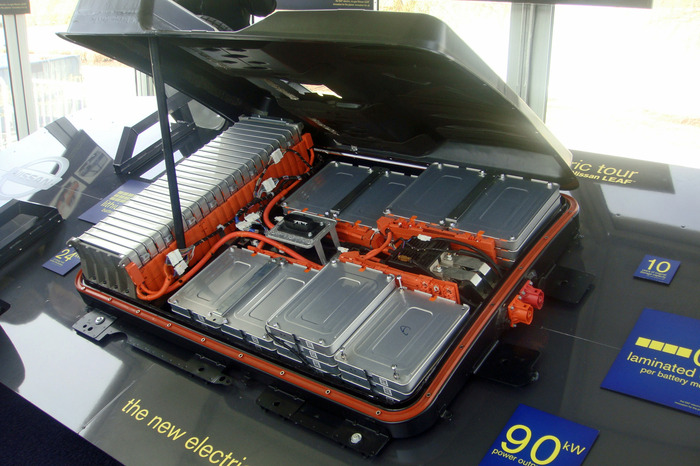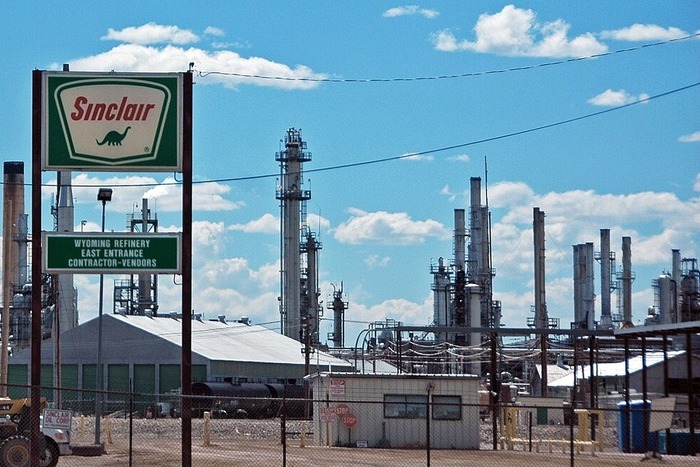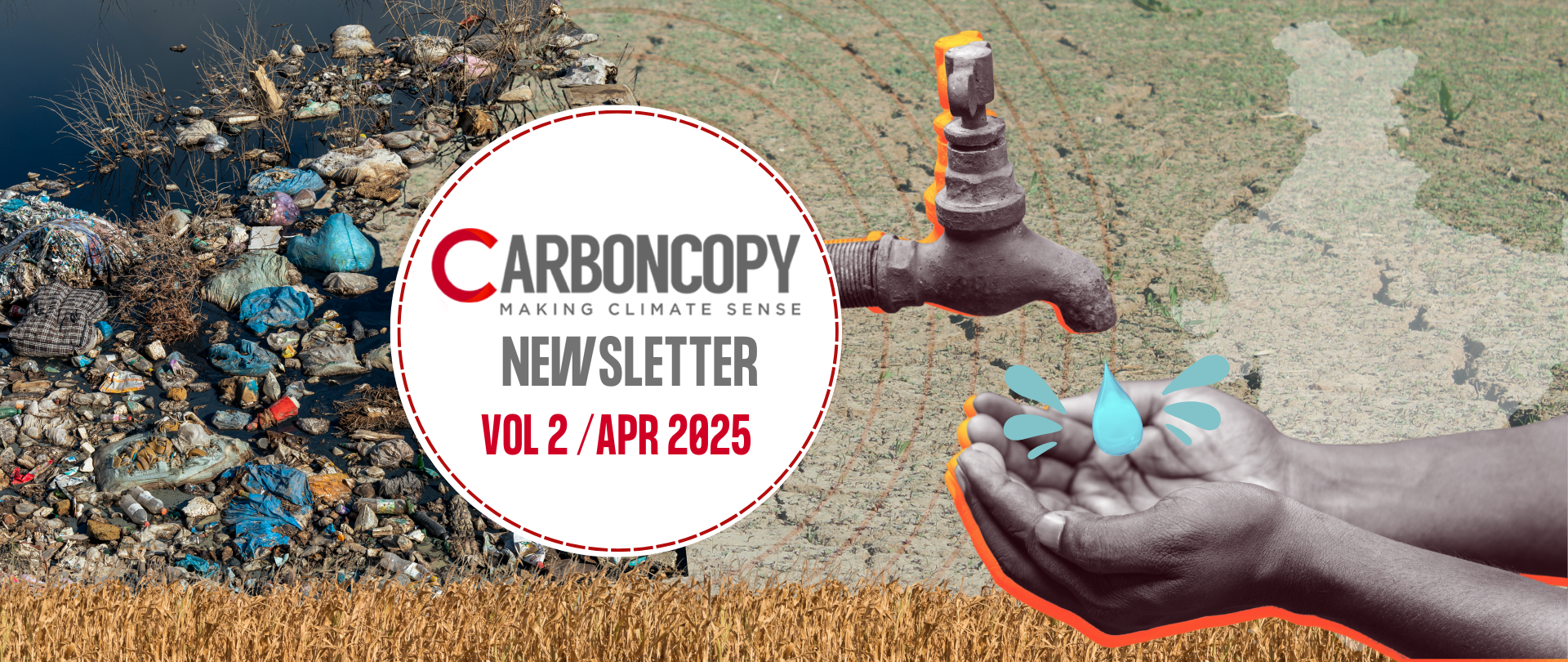
Despite India having 4% of the world’s total freshwater resources, its quality is very poor. Creatives: Riddhi Tandon
From waste to resource: Can urban India turn the tide on its water crisis?
As taps run dry, experts push for reuse, recharge, and a radical rethink of how cities manage water
India ranks among the most water-stressed countries. According to the 2023 Aqueduct Water Risk Atlas released by the World Resources Institute (WRI), India stands 24th out of 25 nations facing “extremely high” water stress. According to the report, this means the country is using at least 80% of its available supply.
Rapid urbanisation is worsening the crisis. Between 2013 and 2023, India’s urban population grew from 32% to 36.36%. In 2024, metro cities—home to over 11.73 crore people—accounted for more than 8% of the national population.
Pressure on water resources is mounting at multiple levels. India recently suspended the Indus Waters Treaty with Pakistan, a landmark agreement signed in 1960 to govern the sharing of river waters. The move comes amid broader tensions, following a terror attack in Kashmir, which took the lives of 26 people, including tourists. It reflects how water scarcity is no longer just a domestic governance challenge, but an increasingly strategic and geopolitical concern.
At home, Indian cities and towns are growing at an unsustainable pace, their water sources are running dry. From shrinking rivers and rapidly falling groundwater to unequal access and rising pollution, the urban water crisis is deepening. Poor planning, unchecked construction, climate impacts, and outdated infrastructure are all making matters worse. Experts say the way forward lies in smarter use of local resources and treating wastewater as a valuable asset. Can India’s cities act in time to secure their water future?
Groundwater realities
A 2018 report by India’s apex think-tank and Niti Aayog predicted that 21 Indian cities — including Delhi, Bangalore, Hyderabad and Chennai — will run out of ground water by 2020. While that hasn’t happened yet, the crisis looms large.
The cities are extracting water at unsustainable rates,” says Dipankar Saha, former member of Central Ground Water Board (CGWB) and currently Chair Professor with Manav Rachna International Institute of Research and Studies (MRIIRS).
Saha explains that almost 70% of India’s geography is hard rock which has low permeability, therefore the water is not easy to recharge.
He says, “In hard rock areas, there is less potential to recharge the source, the groundwater level is falling rapidly but the rate of extraction remains the same or going up.” Saha gives an example of Faridabad city, which is adjacent to Delhi and running out of groundwater. “Even though the city is at the banks of river Yamuna, the dependence is entirely on groundwater. Since there is no recharge commensurate with the heavy rate of extraction the water table has fallen sharply.,” he adds.
Day zero cities and dying rivers
In 2019, Chennai nearly ran dry. Officials had to declare a “Day Zero” situation in the city when its four main reservoirs almost ran out of water. Queues, chaos, and emergency water tankers ensued. Researchers attributed the problem to poor planning and destruction of water bodies in India’s sixth-largest city with an estimated population of more than 10 million.
But Chennai is just one example. The World Wide Fund for Nature (WWF) listed 100 cities who will face ‘grave water risk’ in 2050. Among them there were 30 Indian cities, including Delhi, Mumbai, Kolkata, Bengaluru, Lucknow and Bhopal. This would be driven by a dramatic rise in the population percentage from 17% in 2020 to 51% in 2050, the report states.
Even hill stations aren’t spared. In 2018, Shimla’s taps ran dry leading to protests by the local population. “In the past two decades, snowfall has reduced. Earlier, we had several feet high snow in these hills between December and March. Now it is hardly a foot high and that too for a few days in the whole year. We have dry winters and less rainfall. There are other problems as well such as unregulated construction and poor waste management, which has killed the aquifers,” says Sanjay Chauhan, a businessman and former mayor of Shimla municipal corporation.
Shimla requires around 45 million litres water per day (MLD) during peak tourist season. But it hardly gets around 30 MLD per day. The story is similar in other hill stations as well such as Nainital, Mussoorie, Kullu, Ooty and Kodaikanal.
“Cities like Chennai, Shimla, and Nainital are warning signs of what uncontrolled demand and environmental carelessness might do. For instance, increased built-up areas and widespread concretisation—along with the filling of ponds and construction that ignores natural water channels—have contributed to more frequent and severe urban flooding,” says Paramita Dey, senior faculty at National Institute of Urban Affairs, New Delhi.
Vanishing rivers, uneven rain
Across India, rivers, too, are vanishing outside monsoon windows. An analysis by the Central Water Commission (CWC) last year found there was “no water left in the rivers between Mahanadi and Pennar basins that flow through Andhra Pradesh, Telangana and Odisha.”
“As a result of climate change, a lot of rain falls in a very short span of time. This means the number of rainy days are less. If you check the data of the past few years, you will find the same big cities, be it Chennai, Delhi, Hyderabad, Lucknow or any other city, are facing droughts and floods in the same year,” says Sushmita Sengupta, Senior Programme Manager of Water Programme with the Center for Science and Environment (CSE).

The Ganga basin is another example. It has seen the lowest snow persistence in 23 years, threatening cities downstream. This water shortage in the river basins gravely affects the socio-economic conditions, livelihoods and agricultural activity of the regions dependent on the rivers. Not to mention the health of the rivers.
“A river’s health depends largely on how quickly rainwater flows into it from its catchment area. The slower the flow, the better the river’s condition; rapid runoff, on the other hand, leads to poor river health. Forests, wetlands, local water bodies, and carbon-rich agricultural fields help absorb and gradually release rainwater, supporting year-round river flow and protecting against both floods and droughts,” says Himanshu Thakkar, Coordinator of South Asia Network on Dams, Rivers and People (SANDRP).
Unequal and unreliable access
This widening gap is not just about scarcity—it’s also about inequality. India’s per capita water availability, according to government data, is declining—from 1,816 cubic metres in 2001 to a projected 1,367 cubic metres by 2031. Urban benchmarks by the government set supply at 135 litres per person daily, but access varies wildly. While some city dwellers enjoy 24/7 piped supply, others—especially in slums—live with chronic shortages. Big cities also often draw water from far-off regions, depriving locals.
This writer documented the water problem in Rajasthan where people ran “No Water, No Vote” campaign during assembly polls in 2018.
Thakkar says there’s no real policy for urban water management. Instead of optimally using local sources like rainwater, ponds, or rivers, cities rely on long-distance transfers, according to him. “We have smart city projects, but there is no definition of a water-smart city. The city should be able to manage and use its local water resources optimally.”
Thakkar recalled that during his time on the working group for the 12th Five Year Plan (2012–17), it was recommended that cities should only be allowed to draw water from external sources if they could first demonstrate optimal use of all local water resources.
Pollution: The other crisis
Even if water is available, it is often unsafe. Despite India having 4% of the world’s total freshwater resources, its quality is very poor. The country ranked 122 out of 124 countries on the World Water Quality Index in 2024. The Niti Aayog report also acknowledges the poor quality of water across India.
Industrial effluents, untreated sewage, and poor waste disposal have left shallow aquifers toxic and rivers choking with contaminants like cadmium, lead, and arsenic.
“The major issue in urban areas is that there are many legal and illegal industrial units running. Besides polluting rivers these industrial units are discharging hazardous chemicals, which percolate into the ground. Even the treatment technology is not up to the mark. It can not treat heavy metals like cadmium, chromium and mercury properly,” Saha told Carboncopy.
“Deep aquifers are still relatively safe, but shallow aquifers are totally contaminated. Some of the contamination like arsenic occurs naturally, but human activities are worsening the problem ” he said.
In response to a question in the Rajya Sabha, the government has admitted to “the occurrence of contaminants such as fluoride, arsenic, nitrate and heavy metals, beyond permissible limits (as per BIS) for human consumption in certain isolated pockets in some States / UTs.”
Despite spending over ₹33,000 crore in four decades, the Ganga remains polluted. A CWC study found 81 Indian rivers and tributaries with dangerously high levels of toxic heavy metals. According to the report, the heavy metals detected beyond safe limits included arsenic, cadmium, chromium, copper, iron, lead, mercury and nickel.
One of the biggest reasons rivers stay polluted is the unchecked dumping of untreated sewage, experts say. Cities along riverbanks routinely release waste directly into the water, and across states, this has become business as usual. Just this month, the National Green Tribunal (NGT) pulled up the governments of Jharkhand and Uttarakhand for allowing untreated sewage to flow into the Ganga.
While river pollution remains a serious concern, government data suggests some progress. According to the Central Pollution Control Board (CPCB), the number of polluted river stretches has dropped from 351 in 2018 to 311 in 2022. Of the 180 stretches out of the 351 flagged as polluted in 2018, water quality improved in all—106 were removed from the polluted list entirely, while 74 were downgraded to a lower-risk category. In 2015, 70% of monitored rivers (275 out of 390) were classified as polluted. By 2022, that figure had dropped to 46% (279 out of 603), according to government assessments.


The way forward
Experts advocate a shift in thinking. Wastewater isn’t a liability, but a resource. A comprehensive water conservation and management policy is the need of the hour. Shifting the thinking from a supply-driven approach to an integrated urban water management system should be key, say experts.
“We have been doing piecemeal planning in many cases. It is a well-established fact that the infrastructure for water supply is capital-intensive. However, we have not focussed adequately on operation and maintenance. User charges are not enough to recover Operation and Maintenance costs. Secondly, we have not been successful in reducing non-revenue water. A lot of water is lost in leakages,” says Dey.
“Decentralised treatment, strong regulatory control, and public confidence-building will help India realise the possibilities of wastewater reuse,” she said.
Cities like Singapore and El Paso, Texas, treat and reuse wastewater to meet up to 40% of their water needs. India has the potential to follow suit—if treatment plants work efficiently and sludge is managed.
But India is able to recycle only a fraction of its wastewater. Over 72,000 MLD of wastewater is generated daily in India, but only 28% is treated. In Delhi, over 1,000 MLD of sewage flows into the Yamuna untreated, despite having 37 STPs—half of which do not meet the standards set by CPCB.
“We use freshwater for everything from bus washing to government buildings,” says environment activist Pankaj Kumar, who is associated with an NGO Earth Warriors, which works to spread awareness about cleaning up the Yamuna. “If we use clean treated water for all these works then the pressure on rivers will reduce, giving them a chance to recharge groundwater,” Kumar said.
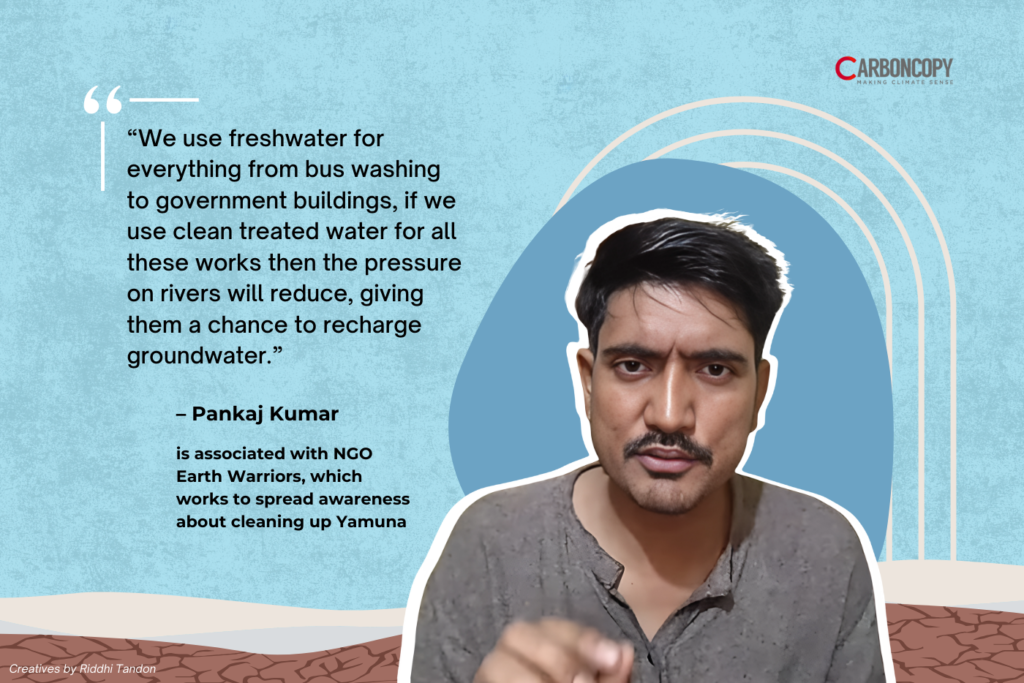
Kumar gives the example of Pappan Kalan in Delhi and some areas in Noida where STPs are working well and the water is being used in agriculture and for groundwater recharge by making ponds.
According to a CEEW report, treated wastewater in India could irrigate 26 times Delhi’s area by 2050. The market value of the treated water will be ₹1.9 billion in 2050. Another report by CEEW last year highlights Haryana, Karnataka, and Punjab are the frontrunners of used water management in India.
Nitin Bassi, Senior Programme Lead with CEEW, said, “Many Indian cities are now water-stressed. For instance, Bengaluru, which draws most of its freshwater from the Kaveri River and borewells, is currently facing a severe water crisis. Reusing used water to its full potential for non-potable purposes will be key in the future.”
Pricing for sustainability
One way to make people responsible and conserve water is to put a price on it. Although people purchase bottled water for drinking, it is largely free in homes. “Free water leads to waste,” says Saha. “If there is a price, it will enhance the water use efficiency,” he said.
Many experts agree with this idea. Globally, a debate on incremental pricing of water is going on and many countries have implemented the idea where consumers pay for water beyond a certain limit and the price increases with the increase of consumption.
“There should be a pricing slab where water is affordable up to a certain limit—enough to meet basic needs. Beyond that, the cost per unit should rise progressively. A cap on total household supply will encourage even wealthier consumers to use water more carefully. For non-potable uses, treated or recycled water should be the norm,” Dey said.

India’s urban water crisis is no longer a looming concern—it is a daily reality for millions. Rivers are shrinking, groundwater is vanishing, and the divide between those with access to clean water and those without is growing starker.
But the solutions are within reach. Cities must shift from extraction to conservation, from treating wastewater as waste to recognising it as a resource. Equally critical is rethinking how we value water—through pricing, equitable access, and better infrastructure management.
The urgency is clear. The question now is—will India’s cities rise to the challenge—or wait until it’s too late?
Photo: Wikimedia Commons
Temperatures soar to 42-45°C, heatwave alerts for many parts of India
The India Meteorological Department (IMD) issued orange and yellow alerts as many parts of the country were hit by a heatwave, with temperatures soaring up to 44°C in several regions, Hindustan Times reported. On Saturday, Kanpur recorded a maximum temperature of 44.4°C, Prayagraj 44.8°C, Sultanpur 44.8°C, Varanasi 44.2°C, Gaya 44.6°C, Jharsuguda 44.7°C, and Delhi Ridge 43.3°C, among others.
“Maximum temperatures are above normal by 3–5°C at many places over Jammu, Punjab, Haryana, Delhi, Uttar Pradesh, Bihar, Northeast and west Rajasthan, North Madhya Pradesh, Vidarbha, adjoining Marathwada, northeast Jharkhand, west Gangetic West Bengal, Sub-Himalayan West Bengal & Sikkim,” the weather agency stated.
Normally, there are four to seven heatwave days between April and June, but this year there could be between six and 10, the IMD had forecast on April 1. Since early April, several stations across India have recorded heatwaves.
Heat danger limit may be closer to 31°C instead of the widely accepted 35°C?
The widely accepted wet-bulb temperature survival threshold of 35°C is being questioned. Recent physiological studies suggest the limit may actually be closer to 31°C, according to Harvard researchers. The findings were shared at an interdisciplinary conference held with the Union Environment Ministry to discuss heat stress in India and adaptation strategies, HT reported.
Wet-bulb temperature is a combined measure of heat and humidity and indicates the lowest temperature to which air can be cooled by evaporating water into it.
Massive flash floods in Jammu and Kashmir’s Ramban wash away NH-44 at 5 locations; three people killed
Heavy flash floods and landslides hit Ramban district in Jammu and Kashmir on April 20, 2025, killing two children and an elderly man in Seri Bagna village. Another cloudburst occurred in Dharamkund village, about 20 km from Ramban town. Around 35 houses were destroyed, of which 10 were washed away, Down to Earth reported.
The floods severely damaged a 4–5 km stretch of the Jammu-Ramban section of NH-44. The highway was damaged at five locations, stranding dozens of passenger vehicles, trucks, and oil tankers. Many vehicles were buried under landslides.
Extended heatwave in India, Pakistan to test survivability limits, with temperatures reaching Death Valley levels
Temperatures in India and Pakistan are expected to climb to dangerous levels this week, CNN reported. Parts of Pakistan may experience temperatures up to 8°C above normal. Climate experts warn that rising temperatures are pushing the limits of human survivability and that by 2050, India may be among the first places to cross those limits.
Pregnant women and their unborn children are particularly at risk. An advisor from the International Confederation of Midwives highlighted a rise in pregnancy-induced hypertension during summer, potentially leading to preeclampsia—the leading cause of maternal mortality.
Ganga basin records lowest snow persistence in 23 years: Report
Snow in the Ganga basin melted at the fastest rate in more than two decades in 2024, according to the International Centre for Integrated Mountain Development (ICIMOD). Snow persistence in the basin was 24.1% below normal, the lowest in 23 years. This is expected to reduce early summer river flows and worsen heat stress and water scarcity.
The Indus basin also saw a sharp drop in snow persistence, from +19.5% in 2020 to -27.9% in 2025. Other regions, including the Mekong (-51.9%), Salween (-48.3%), Tibetan Plateau (-29.1%), Brahmaputra (-27.9%), and Yangtze (-26.3%), also saw significant declines, DTE reported.
Most of India Saw 3-10% Decline in Solar Irradiation in 2024
Extreme weather and poor air quality led to a 3–10% fall in solar irradiation across India in 2024, Mercom reported. The monsoon season saw rainfall exceeding the long-term average by nearly 8% above average. While this benefited agriculture and reservoirs, it hampered solar power generation.
Research by Solargis noted that air pollution, particularly during winter, significantly impacted solar output. January 2024 saw persistent fog and smog in Northern India for up to 20 days, with Global Horizontal Irradiance dropping 30–50% below average.
Deadly floods, storms and heatwaves: Europe suffered the ‘serious impacts’ of climate change in 2024
Floods and storms affected 413,000 people across Europe last year, according to the EU’s Copernicus Climate Change Service (C3S). The continent also recorded its hottest year, with 45% of days much warmer than average and 12% setting new heat records, Euronews and The Guardian reported.
South-eastern Europe endured its longest recorded heatwave in July 2024, lasting 13 days and triggering wildfires affecting 42,000 people. Western Europe saw one of its wettest years since 1950, with floods hitting 30% of its river networks and causing damages exceeding €18 billion, Reuters reported.
Global warming exposed 2,466 km of new coastline in the arctic in 20 years: report
Global warming has been causing accelerated melting of glaciers in mountains and the two poles. In the Arctic, this has caused marine terminating glaciers — whose boundaries end in the ocean — to retreat at a rapid pace in the 21st century.
This has caused coastlines and land to appear in these regions, which were historically always covered in ice, reported CarbonCopy citing a study published in Nature. Around 2,466 km of coastline was uncovered between 2000 and 2020.
Around 66% of the new coastlines are to be found in mineral-rich Greenland, according to the study. It also found that these young paraglacial coastlines are highly dynamic, exhibiting high sediment fluxes and rapidly evolving landforms.
Photo: Wikimedia Commons
‘Exceptional’ power outage in Spain and Portugal affects millions of people
A major power failure brought much of Spain and Portugal to a standstill on Monday, halting trains, cutting phone service, and shutting down traffic lights and ATMs across the Iberian Peninsula, AP reported. Portuguese grid operator REN said the outage was caused by a rare atmospheric phenomenon—extreme temperature variations triggering “induced atmospheric vibration” in high-voltage lines, leading to synchronization failures in the European network, Guardian reported.
Reuters said that “outages on such a scale are extremely rare in Europe”. A second Reuters article said Spain’s generation was “nearly back to normal” as of Tuesday morning, while a third Reuters piece says Portugal had also restored supplies.
Centre Offers ₹1 Lakh to Set Up Natural Farming Input Centres; Experts Call it Inadequate
The government has issued guidelines under the National Mission on Natural Farming (NMNF) for setting up bio-input resource centres (BRCs), offering financial assistance of ₹1 lakh per centre, DTE reported. These centres aim to support farmers with locally available bio-inputs. The outlet added that BRCs are cluster-level enterprises, meant to support local production, availability and supply of ready-to-use bio-inputs for natural farming to farmers who may not be able to produce them individually.
Experts, however, flagged the amount as insufficient. ““If a person who is setting up the centre has land and other kind of physical infrastructure with them and if it’s just about setting the centre and running it in terms of the production, then this Rs 1 lakh should be decent enough for a low-scale model. Otherwise, this amount is not sufficient because there are factors like land costing, other physical infrastructure like shed building which cannot be done within Rs 1 lakh,” said Manjula M, agricultural economist at Azim Premji University, as reported by Down To Earth.
Wildlife board likely to form agenda review sub-committee
The Standing Committee of the National Board for Wildlife (NBWL) is likely to form a sub-committee to review agendas at least three days before the board’s meetings, according to minutes from its April 15 session, reported HT. The move follows the seventh meeting chaired by Prime Minister Narendra Modi in March.
“A small sub-committee may be formed to review agendas at least three days in advance of meetings… In conclusion, a structured, collaborative, and multi-stakeholder approach is essential for effective conservation planning. The initiatives undertaken in this regard shall be instrumental in shaping long-term environmental policies and sustainable development practices,” the minutes added.
All authors working on flagship US climate report are dismissed
The Trump administration has dismissed hundreds of volunteer scientists and experts working on the National Climate Assessment (NCA), The New York Times reported. The NCA is the federal government’s flagship climate report, examining how rising temperatures affect sectors like health, agriculture, water supply, and energy.
Contributors to the sixth NCA, scheduled for 2028, were informed via email that the report’s scope was being “re-evaluated” and that their services were no longer required.
Despite trade tensions, China holds lead in clean energy manufacturing
China’s role as the world’s leading clean energy manufacturer remains intact despite rising trade tensions and shifting climate policies, thanks to its broad export base, cost competitiveness and technological edge, according to the latest analysis from Moody’s Ratings.
While new US tariffs could push companies to diversify their supply chains, China’s entrenched position in the market “limits the pace at which companies can shift away”, Moody’s Ratings said in an infographic released on Tuesday. Moody’s highlighted China’s ability to serve more than 200 countries and regions as a critical advantage in navigating trade barriers.
US tariffs could shave up to half a percentage point off India GDP, says finance secretary
India’s Finance Secretary Ajay Seth said US tariffs introduced by the Trump administration could reduce India’s GDP growth by 0.2 to 0.5 percentage points. Speaking at a Hudson Institute event during the Spring Meetings of the IMF and World Bank, Seth confirmed that India is in ongoing negotiations with the US on trade issues, Reuters reported.
Photo: Wikimedia Commons
NGT notice to Uttarakhand, Jharkhand over untreated sewage polluting Ganga
The National Green Tribunal (NGT) issued notices to Uttarakhand and Jharkhand, seeking explanations for why sewage treatment plants (STPs) remain non-functional and untreated effluents continue to pollute the Ganga River, HT reported.
A compliance affidavit by the Uttarakhand Pollution Control Board disclosed that most STPs were not meeting norms and were frequently found non-operational. This contradicts claims by the Jal Shakti Ministry, which had earlier stated that water quality met bathing criteria across Uttarakhand and Jharkhand stretches of the Ganga.
Shipping’s climate deal sets up battle over pollution calculations for gas and biofuels
The International Maritime Organization (IMO) will introduce emissions intensity benchmarks for various fuels, which will determine penalties or rewards for ship operators, Climate Home News reported.
Supporters of liquefied natural gas (LNG), biofuels and a green hydrogen-based fuel called methanol are submitting proposals to the IMO, arguing for lower emissions intensity calculations, backed by governments supportive of each technology. Environmentalists call LNG a greenwash, not only because it’s a fossil fuel, but also because it has methane emissions at all stages of extraction, transportation and end use.
Advanced technology like satellites has revealed that these leaks are worse than thought. A study last year found that importing gas to burn for electricity can be more polluting than using local coal for the same purpose.
AI-powered tech supercharges ocean cleanup, boosting plastic collection by 60%
A new study found that AI algorithms can increase the efficiency of ocean plastic collection by over 60%. By optimising ship routes in real time, The Ocean Cleanup project is now able to extract more plastic per sweep, making operations significantly more effective.
“By optimising routes in real time, we ensure every sweep collects as much plastic as possible, making cleanup operations significantly more effective.” said Dick den Hertog from the University of Amsterdam.
Photo: Wikimedia Commons
ISTS Waiver Expiry Could Derail India’s 2030 Renewable Targets
India’s renewable energy developers are seeking an extension to the interstate transmission system (ISTS) charges waiver, set to expire on June 30, 2025. Mercom reported that the waiver currently enables commercial and industrial users to access renewables at lower costs, thereby supporting India’s 500 GW non-fossil capacity goal for 2030.
Energy Storage Funding Declines Sharply in Q1 2025
Private sector funding for energy storage companies fell sharply to $2.2 billion in Q1 2025—an 81% drop from $11.7 billion in the same quarter last year, according to Mercom. CEO Raj Prabhu attributed the decline to geopolitical and policy uncertainties, stalled subsidy programs, and high import tariffs affecting the battery and EV sectors.
China’s wind, solar energy capacity surpasses thermal power for first time
China’s installed capacity of wind and solar power reached 1,482 gigawatts (GW) by the end of March, surpassing that of thermal power “for the first time in history”, state news agency Xinhua reports. Wind and solar capacity are expected to “maintain the lead over thermal power”, said the National Energy Administration, adds the news agency.
China approves 10 new reactors for fourth straight year
China approved the construction of 10 new nuclear reactors, with a combined investment of more than 200 billion yuan ($27.4 billion), the Hong Kong-based South China Morning Post (SCMP) reported. China now has 30 reactors under construction, around 50% of the global total, and is expected to “leapfrog the US to become the world’s largest atomic energy generator by the end of the decade”, reported Bloomberg. The news outlet said that it’s “the fourth year in a row that China has approved at least 10 new reactors”. China now has a total of 102 nuclear power units either “in operation, under construction, or approved for construction”, with an installed capacity reaching 113 gigawatts (GW), according to state broadcaster CCTV.
Meanwhile, China’s hydrogen energy production and consumption exceeded 36m tonnes in 2024, “ranking first in the world”, reported Xinhua, citing a National Energy Administration (NEA) press conference.
US sets tariffs of up to 3,521% on south-east Asia solar panels
The Trump administration will impose tariffs of up to 3,521% on solar panels imported from Cambodia, Thailand, Malaysia, and Vietnam, BBC reported. Some manufacturers like Cambodia-based exporters faced the steepest penalties due to limited cooperation with US investigations.
The duties vary between companies and the countries their products are made in.
Some solar equipment exporters in Cambodia face the highest duties of 3,521% because of what was seen as a lack of cooperation with the Commerce Department investigation. Products made in Malaysia by Chinese manufacturer Jinko Solar faced some of the lowest duties of just over 41%. Another China-based firm, Trina Solar, faces tariffs of 375% for the products it makes in Thailand.
97% of global business leaders want rapid transition to renewables: report
A poll conducted by the London-based consultancy firm Savanta of business executives across 15 countries shows that there’s overwhelming support for the rapid transition to renewable-based electricity, CarbonCopy reported. The poll’s data makes up a larger study titled ‘Powering up: Business perspectives on shifting to renewable electricity’. It shows that a global tipping point is coming in the corporate sector as well, with 97% of business leaders wanting to not use fossil fuels like coal anymore. Also, 78% of the surveyed executives are looking to shift to a completely renewables-based electricity system by 2035 or sooner.
Savanta surveyed a total of 1,477 business leaders from Australia, Brazil, Canada, Germany, India, Indonesia, Italy, Japan, Mexico, Poland, South Africa, South Korea, Türkiye, UK and US.
Trade war between US and China paves way for expansion of sodium-ion batteries production
Sodium-ion batteries, a cheaper and less combustible alternative to lithium-ion ones, are becoming more attractive in the US, thanks to growing concerns about trade war with China, reported Bloomberg. China controls the majority of the supply chain for lithium-ion batteries. With uncertainty over the supply of materials from China, and US President Donald Trump’s intentions of placing high tariffs on materials imported from China, developing sodium-ion batteries look like a far cheaper alternative.
BYD changes tactics to penetrate European market
Leading Chinese EV maker is making strategic changes to its Europe expansion policy after its initial thrust to penetrate the market wasn’t very successful, according to Reuters. Reasons include not onboarding enough auto dealers on their roster, and not hiring substantial European executives with local market knowledge. Furthermore, BYD is realigning its offering of only EVs to hybrids now, which are more attractive in Europe.
China’s leading EV maker BYD is overhauling its European operations after strategic missteps including failures to sign up enough dealers and hire executives with local-market knowledge and to offer hybrids in markets resistant to fully electric vehicles, six current and former BYD executives said.
Mercedes CEO hopes for alternatives to tariffs on Chinese EVs in EU market
Ola Källenius, the CEO of Mercedes-Benz, said the German automaker is urging the EU to find an “equitable solution” for tariffs imposed on Chinese EVs being sold in Europe, reported Reuters. He wished the EU created “a level-playing field for China-made electric vehicles in Europe”, as “a pure tariff barrier was the crudest instrument”. In October 2024, the EU increased tariffs on Chinese EVs to 45.3%. However, the EU and Chinese governments are considering the case of lifting tariffs using minimum price mechanisms for imported cars.
Photo: Wikimedia Commons
Indian refiners purchase more US crude before trade talks in May
Indian refiners increased the purchase of US oil before trade talks between the two nations next month, Bloomberg reported.
The newspaper said, around 11.2 million barrels of crude are set to arrive in India from the US in June, the highest volume since last August, according to provisional data from analytics firm Kpler Ltd. That comes after a drop in prices in the West Texas Intermediate benchmark as the result of lower demand because of a refinery overhaul in Singapore, along with reduced appetite in China — the world’s biggest oil importer.
The outlet added that: “WTI has to discount significantly more than usual to incentivize the rest of Asia to take in the barrels,” said June Goh, a senior oil market analyst at Sparta Commodities. “There is also a geopolitical element, where Asian buyers may seek more WTI as a negotiating tool with the US to reduce the reciprocal tariffs, per what we are observing with Indonesia and India.”
China, India leading global clean energy transition, but new BRICS members pursuing fossil fuels : Global Energy Monitor
The Global Energy Monitor (GEM/0 said the founding BRICS members — India, Brazil and China continue to lead the global clean energy transition, but countries that have recently joined them are pursuing fossil fuels. The bloc can play a crucial role in the power sector buildout by backing clean energy power projects across new bloc members.
The GEM report said fossil-powered capacity dropped below half of the total mix in the BRICS group for the first time in 2024. However, new BRICS members are building more than 10 times as much coal, oil, and gas capacity (25 GW as wind and utility-scale solar (2.3 GW).
But data in the Global Integrated Power Tracker also show 25 GW of coal, oil, and gas capacity under construction in the newest BRICS countries — Indonesia, Belarus, Bolivia, Kazakhstan, Cuba, Malaysia, Thailand, Uganda, Uzbekistan, and Nigeria — versus just 2.3 GW of wind and utility-scale solar under construction.
GB News Broadcast Almost 1,000 Anti-Climate Attacks Before and After 2024 Election
According to the Desmond report, Britain’s TV channel GB News gave a platform to at least 953 anti-climate attacks in the 2024 general election. the channel’s “wild and paranoid conspiracy claims” ahead of May’s local elections.
Half of these featured attacks on clean energy policies, including that the goal of reducing emissions to net zero by 2050 is a “cult” and a “monster”, the report said.
The outlet noted that the broadcaster aired an average of around 4.5 anti-climate claims per day during the period from 31 May to 31 December, with attacks on climate science, policy, or environmental groups featuring in almost 12 percent of all half-hour segments. At least 74 of these anti-climate statements were made by current or former representatives of Nigel Farage’s Reform UK and its predecessor party, the Brexit Party, several of whom are GB News hosts.
China to keep building coal plants through 2027
China plans to keep building coal-fired power plants through 2027 in some regions to meet peak power demand or stabilise the grid, according to government guidelines for upgrading the coal power system, reported Reuters. That policy says new coal projects are considered a back-up for renewable generation whose output depends on sunlight and wind conditions.
The guidelines, issued by the state planner and energy regulator, stated that newly built coal plants should have 10-20% lower carbon emissions per unit of power output than the 2024 fleet, and also call for upgrades to some existing coal plants to meet those conditions.
Newly built and upgraded coal plants should also be able to safely and reliably adjust their output to help meet peak power demand.

